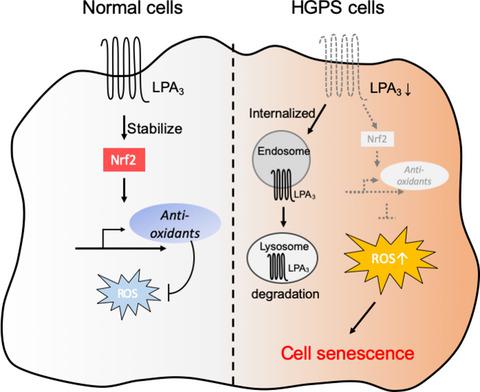当前位置:
X-MOL 学术
›
Aging Cell
›
论文详情
Our official English website, www.x-mol.net, welcomes your
feedback! (Note: you will need to create a separate account there.)
Lysophosphatidic acid receptor LPA3 prevents oxidative stress and cellular senescence in Hutchinson-Gilford progeria syndrome.
Aging Cell ( IF 8.0 ) Pub Date : 2019-11-12 , DOI: 10.1111/acel.13064 Wei-Min Chen,Jui-Chung Chiang,Yueh-Chien Lin,Yu-Nung Lin,Pei-Yun Chuang,Ya-Chi Chang,Chien-Chin Chen,Kao-Yi Wu,Jung-Chien Hsieh,Shih-Kuo Chen,Wei-Pang Huang,Benjamin P C Chen,Hsinyu Lee
Aging Cell ( IF 8.0 ) Pub Date : 2019-11-12 , DOI: 10.1111/acel.13064 Wei-Min Chen,Jui-Chung Chiang,Yueh-Chien Lin,Yu-Nung Lin,Pei-Yun Chuang,Ya-Chi Chang,Chien-Chin Chen,Kao-Yi Wu,Jung-Chien Hsieh,Shih-Kuo Chen,Wei-Pang Huang,Benjamin P C Chen,Hsinyu Lee

|
Hutchinson–Gilford progeria syndrome (HGPS) is a rare laminopathy that produces a mutant form of prelamin A, known as Progerin, resulting in premature aging. HGPS cells show morphological abnormalities of the nuclear membrane, reduced cell proliferation rates, accumulation of reactive oxygen species (ROS), and expression of senescence markers. Lysophosphatidic acid (LPA) is a growth factor‐like lipid mediator that regulates various physiological functions via activating multiple LPA G protein‐coupled receptors. Here, we study the roles of LPA and LPA receptors in premature aging. We report that the protein level of LPA3 was highly downregulated through internalization and the lysosomal degradation pathway in Progerin‐transfected HEK293 cells. By treating Progerin HEK293 cells with an LPA3 agonist (OMPT, 1‐Oleoyl‐2‐O‐methyl‐rac‐glycerophosphothionate) and performing shRNA knockdown of the Lpa3r transcript in these cells, we showed that LPA3 activation increased expression levels of antioxidant enzymes, consequently inhibiting ROS accumulation and ameliorating cell senescence. LPA3 was shown to be downregulated in HGPS patient fibroblasts through the lysosomal pathway, and it was shown to be crucial for ameliorating ROS accumulation and cell senescence in fibroblasts. Moreover, in a zebrafish model, LPA3 deficiency was sufficient to cause premature aging phenotypes in multiple organs, as well as a shorter lifespan. Taken together, these findings identify the decline of LPA3 as a key contributor to the premature aging phenotypes of HGPS cells and zebrafish.
中文翻译:

溶血磷脂酸受体LPA3可防止Hutchinson-Gilford早衰综合征的氧化应激和细胞衰老。
Hutchinson–Gilford早衰综合症(HGPS)是一种罕见的椎板病,会产生突变形式的prelamin A,即Progerin,导致早衰。HGPS细胞显示出核膜的形态异常,细胞增殖速率降低,活性氧(ROS)积累和衰老标记物的表达。溶血磷脂酸(LPA)是一种类似于生长因子的脂质介体,可通过激活多个LPA G蛋白偶联受体来调节各种生理功能。在这里,我们研究了LPA和LPA受体在过早衰老中的作用。我们报告说,在Progerin转染的HEK293细胞中,LPA 3的蛋白水平通过内在化和溶酶体降解途径被高度下调。通过用LPA 3处理Progerin HEK293细胞激动剂(OMPT,1-油酰基-2-O-甲基-rac-甘油磷酸硫代酸酯)并在这些细胞中对Lpa3r转录物进行shRNA敲除,我们发现LPA 3激活可增加抗氧化酶的表达水平,从而抑制ROS积累并改善细胞衰老。LPA 3在HGPS患者成纤维细胞中通过溶酶体途径被下调,并且对于改善成纤维细胞中的ROS积累和细胞衰老至关重要。此外,在斑马鱼模型中,LPA 3不足足以在多个器官中引起过早的衰老表型,并且寿命较短。综上所述,这些发现确定了LPA 3的下降 是HGPS细胞和斑马鱼过早衰老表型的关键因素。
更新日期:2019-11-12
中文翻译:

溶血磷脂酸受体LPA3可防止Hutchinson-Gilford早衰综合征的氧化应激和细胞衰老。
Hutchinson–Gilford早衰综合症(HGPS)是一种罕见的椎板病,会产生突变形式的prelamin A,即Progerin,导致早衰。HGPS细胞显示出核膜的形态异常,细胞增殖速率降低,活性氧(ROS)积累和衰老标记物的表达。溶血磷脂酸(LPA)是一种类似于生长因子的脂质介体,可通过激活多个LPA G蛋白偶联受体来调节各种生理功能。在这里,我们研究了LPA和LPA受体在过早衰老中的作用。我们报告说,在Progerin转染的HEK293细胞中,LPA 3的蛋白水平通过内在化和溶酶体降解途径被高度下调。通过用LPA 3处理Progerin HEK293细胞激动剂(OMPT,1-油酰基-2-O-甲基-rac-甘油磷酸硫代酸酯)并在这些细胞中对Lpa3r转录物进行shRNA敲除,我们发现LPA 3激活可增加抗氧化酶的表达水平,从而抑制ROS积累并改善细胞衰老。LPA 3在HGPS患者成纤维细胞中通过溶酶体途径被下调,并且对于改善成纤维细胞中的ROS积累和细胞衰老至关重要。此外,在斑马鱼模型中,LPA 3不足足以在多个器官中引起过早的衰老表型,并且寿命较短。综上所述,这些发现确定了LPA 3的下降 是HGPS细胞和斑马鱼过早衰老表型的关键因素。











































 京公网安备 11010802027423号
京公网安备 11010802027423号